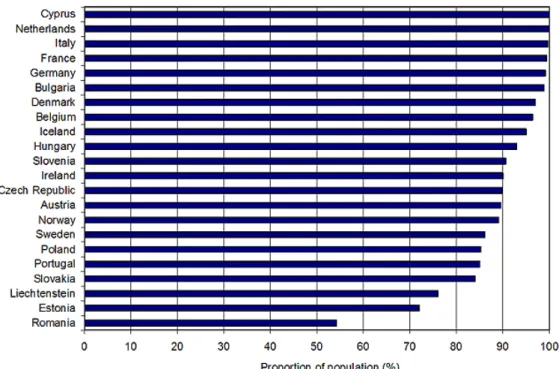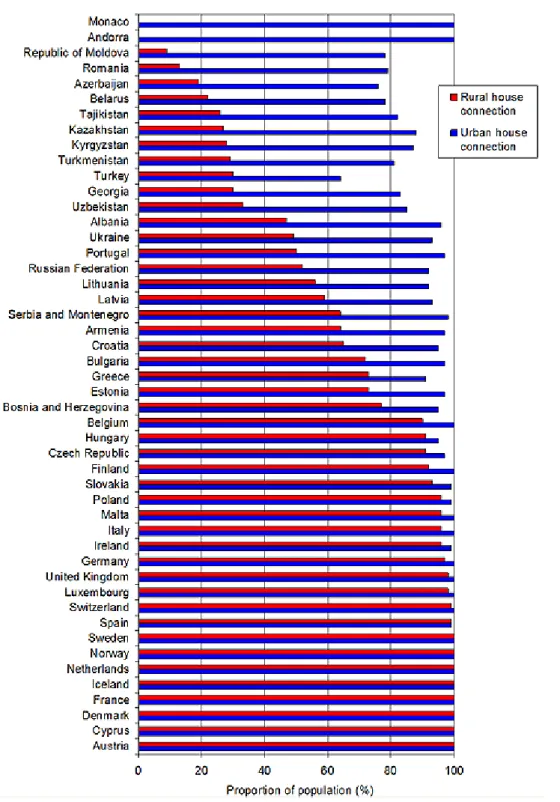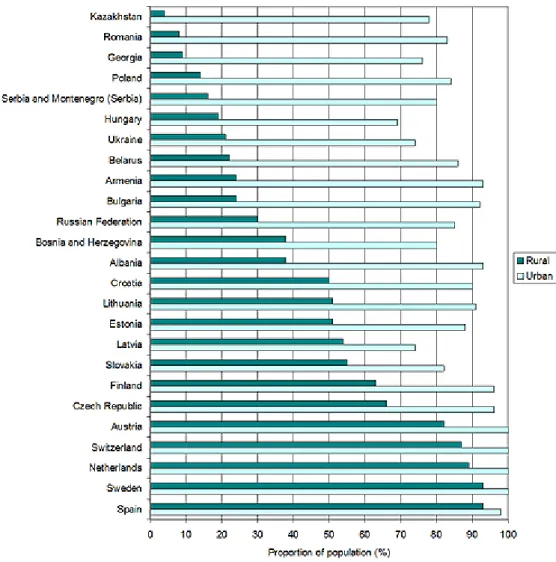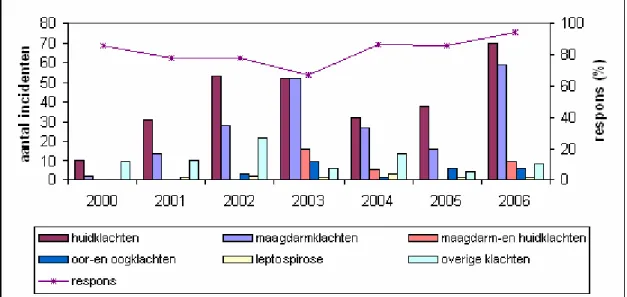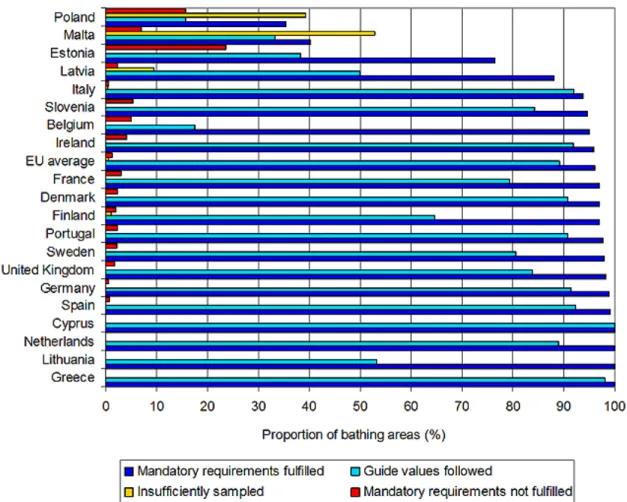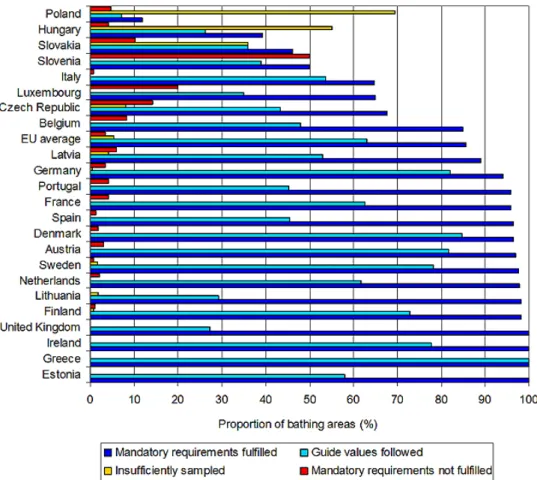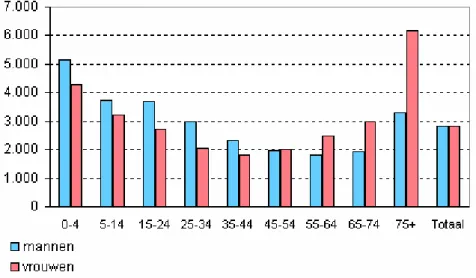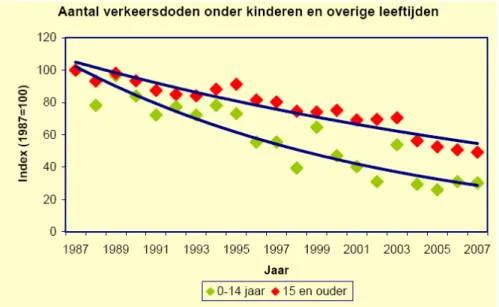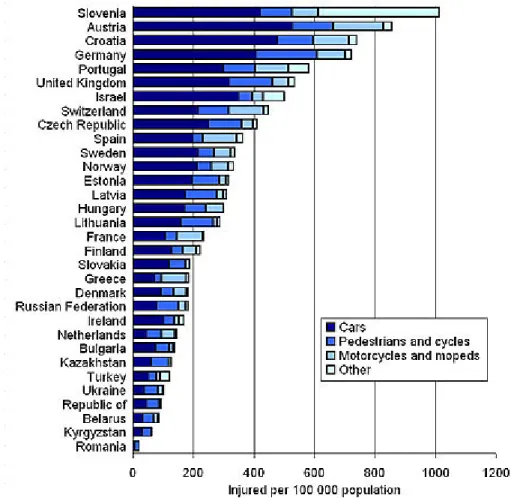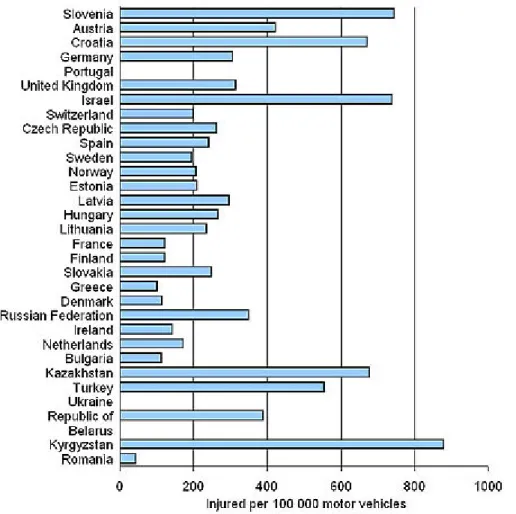Report 630789005/2010
D.A. Houweling | E.A. Koudijs | A.J.P. van Overveld | C. Vros
Towards a healthy, child-friendly
living environment: an overview
of Dutch policy
RIVM Letter report 630789005/2010
Towards a healthy, child-friendly living environment:
an overview of Dutch policy
Status report for the 2010 Parma Ministerial Conference
Houweling, D.A. Koudijs, E.A. van Overveld, A.J.P. Vros, C.
Contact: Ellen Koudijs
Centre for Environmental Health Ellen.Koudijs@rivm.nl
This investigation has been performed by order and for the account of the Dutch Ministry of Housing, Spatial Planning and the Environment, within the framework of the Environmental Health Knowledge and Information Centre (subproject CEHAPE (M/630789/07/CE)).
© RIVM 2010
Parts of this publication may be reproduced, provided acknowledgement is given to the 'National Institute for Public Health and the Environ-ment', along with the title and year of publication.
Abstract
Towards a healthy, child-friendly living environment: an overview of Dutch policy Status report for the 2010 Parma Ministerial Conference
Increasing consideration is being given to the healthy, child-friendly planning of the living environment in the Netherlands. Particularly in the fields of physical activity and indoor air quality, numerous policy initiatives have been implemented to improve children’s health and well-being.
In Europe, many children are still adversely affected by environmental hazards. At the WHO Ministe-rial Conference on Environment and Health in Budapest in 2004, the Netherlands was one of fifty-two European nations which agreed to pay greater attention to measures addressing the impact of environ-mental hazards upon children’s health by adopting the Children's Environment and Health Action Plan for Europe (CEHAPE). This is built around four Regional Priority Goals: safe water and adequate sani-tation (RPG I); protection from injuries and adequate physical activity (RPG II); clean outdoor and in-door air (RPG III); and chemical-free environments (RPG IV).
Within this framework, each country has set its own priorities in a national Children’s Environment and Health Action Plan (CEHAP). The Netherlands has incorporated the RPGs into its CEHAP, known as the Youth Environmental and Health Action Plan.
The commitments made in Budapest are to be reviewed during the WHO Ministerial Conference on Environment and Health, at Parma in March 2010. This report provides a current overview of Dutch government activities in respect of each RPG. As such, it is intended to serve as a background docu-ment in preparing for the Ministerial Conference.
Since 2005 the Netherlands has initiated a number of policy actions to ensure a child-friendly environ-ment, to encourage physical activity by children (RPG II) and to improve the quality of the indoor envi-ronment (RPG III). Measures have also been taken to ensure a safe water supply (RPG I) and to reduce exposure to hazardous chemicals and physical and biological agents (RPG IV).
Key words:
Contents
Summary ... 5
1 Introduction ... 7
1.1 Purpose of this report... 7
1.2 Background ... 7
1.3 About CEHAPE... 7
1.4 CEHAPE in the Netherlands... 8
1.5 Approach... 8
1.6 Structure of the report... 9
2 Regional Priority Goal I... 10
2.1 Context ... 10
2.2 Progress ... 10
2.3 Figures and trends: gastrointestinal diseases... 10
3 Regional Priority Goal II ... 11
3.1 Context ... 11
3.2 Progress ... 12
3.3 Figures and trends: road traffic accidents, other accidents and obesity ... 13
4 Regional Priority Goal III ... 14
4.1 Context ... 14
4.2 Progress ... 14
4.3 Figures and trends: asthma ... 15
5 Regional Priority Goal IV... 17
5.1 Context ... 17
5.2 Progress ... 17
5.3 Figures and trends: cognition and skin cancer... 18
6 Conclusion... 19
References ... 20
Appendix 1: Current status of Dutch policy in respect of the Regional Priority Goals in the Children’s Environment and Health Action Plan for Europe (CEHAPE)... 22 Appendix 2: Trends in environment-related health indicators in the Netherlands and Europe. 47
Summary
Because many children in Europe are still suffering the consequences of environmental hazards, it was agreed at the 2004 WHO Ministerial Conference on Environment and Health that policy in these fields would pay more attention to young people. Children are particularly sensitive to hazards in the envi-ronment, and in some cases are subject to greater exposure. Lessening or eliminating risk factors of this kind therefore has the potential to deliver major health benefits for them.
The agreements reached in Budapest are set out in the Children’s Environment and Health Action Plan for Europe (CEHAPE). This describes measures that countries can take to prevent or reduce the effects of environmental pollutants on children. Specifically, it focuses upon four so-called Regional Priority Goals (RPGs).
• RPG I Reduce the morbidity and mortality arising from gastrointestinal disorders by ensuring adequate access to safe, affordable water and sanitation.
• RPG II Prevent health consequences from accidents and injuries, and pursue a decrease in morbidity by promoting adequate physical activity.
• RPG III Prevent respiratory disease due to outdoor and indoor air pollution, and in particular reduce the frequency of asthmatic attacks.
• RPG IV Reduce the risk to health arising from exposure to hazardous chemicals, excessive noise and biological agents, and guarantee safe working environments.
Taking CEHAPE as its starting point, a 2005 assessment by the Dutch National Institute for Public Health and the Environment (RIVM) identified those points requiring a greater policy effort by the Netherlands in order to comply with the agreements reached at Budapest (van Overveld and Houwel-ing, 2005). This study showed that the nation was broadly compliant with most of the points agreed internationally, but that further effort was none the less required in certain areas, most of them pertain-ing to RPG II and III. For example, policy opportunities were identified in respect of children’s livpertain-ing environment, both indoor and outdoor. Based upon this assessment, the Ministry of Housing, Spatial Planning and the Environment (VROM) drew up a Youth Environmental Health Action Plan (VROM, 2006). In March 2010, the 2004 Budapest agreements are to be evaluated at a Ministerial Conference in Parma.
The present report summarizes the current status of Dutch policy action in respect of each RPG. This includes activities focusing upon one or other of those goals, even when they are not contained in the Youth Environmental Health Action Plan. The summary is based upon data gathered in 2009 for a WHO survey1 and information obtained from contact persons at VROM, in the Ministries of Health, Welfare and Sport (VWS), Agriculture, Nature and Food Quality (LNV) and Transport, Public Works and Water Management (V&W), as well as the special Ministry for Youth and Families (J&G). The report is intended as a background document, for use in preparing for the Ministerial Conference in Parma.
The assessment reported here reveals that numerous actions related to RPG II and III have been pur-sued in the Netherlands, in order to make the living environment more child-friendly, to encourage physical activity and to improve the quality of the indoor environment at schools, at childcare facilities and in the home. Specific, concerted regard for child health and development when shaping the living environment has increased in recent years. And young people are more frequently being involved in the
development and implementation of policy. Moreover, there has also been policy action in respect of RPG I and IV.
This report does not assess whether or not the activities described are effective. Nor does it provide answers to questions concerning their contribution towards achieving policy objectives or related to possible policy gaps. The effectiveness of the policy action taken is to be evaluated later this year, with its results reported in the State of the Living Environment of September 2010.
1
Introduction
1.1
Purpose of this report
Once every five years, WHO Europe organizes a Ministerial Conference on Environment and Health. Because many children in Europe are still suffering the consequences of environmental hazards, it was agreed at the 2004 conference in Budapest to focus policy upon young people. The agreements reached are set out in the Children’s Environment and Health Action Plan for Europe (CEHAPE). Children are particularly sensitive to hazards in the environment, and in some cases are subject to greater exposure. Policy action designed to lessen or eliminate risk factors of this kind therefore has the potential to de-liver major health benefits for them.
The Budapest commitments are to be evaluated at the next Ministerial Conference on Environment and Health, at Parma in March 2010. This report summarizes the policy action taken in the Netherlands, as a result of the 2004 agreements, to improve children’s health and environment. It also outlines devel-opments here in respect of relevant environment-related health indicators and compares the situation with that in other countries. The report is intended as a background document, for use in preparing for the Ministerial Conference in Parma.
1.2
Background
Towards the end of the 1980s, a number of European countries committed themselves to preventing and reducing health risks associated with environmental factors. In pursuit of that objective, WHO Europe began organizing a quinquennial Ministerial Conference on Environment and Health. The first was held in Frankfurt in 1989. Its aim was to bring together various relevant sectors in Europe, in order to initiate policy and action in the field of environment and health.
Each conference ends with the signing of a Ministerial Declaration, in which the Member States com-mit themselves to the agreements reached. At Helsinki in 1994, for example, they agreed that each na-tion would compile a Nana-tional Environment and Health Acna-tion Plan (NEHAP). The Dutch versions of that document are the Health and Environment Action Programme for 2002-2006 and the subsequent National Action Plan on Environment and Health.
At the Budapest conference in 2004, the Netherlands was one of fifty-two European nations which agreed to pay greater attention to measures addressing the impact of environmental hazards upon chil-dren’s health. This commitment was enshrined in the Children's Environment and Health Action Plan for Europe (CEHAPE).
1.3
About CEHAPE
Under CEHAPE, each Member State is expected to take actions which contribute towards one or more of the four so-called Regional Priority Goals defined in the plan, as follows.
• RPG I Reduce the morbidity and mortality arising from gastrointestinal disorders by ensuring adequate access to safe, affordable water and sanitation.
• RPG II Prevent health consequences from accidents and injuries, and pursue a decrease in morbidity by promoting adequate physical activity.
• RPG III Prevent respiratory disease due to outdoor and indoor air pollution, and in particular reduce the frequency of asthmatic attacks.
• RPG IV Reduce the risk to health arising from exposure to hazardous chemicals, excessive noise and biological agents, and guarantee safe working environments.
1.4
CEHAPE in the Netherlands
Taking CEHAPE as its starting point, in 2005 the RIVM assessed where Dutch policy requires an addi-tional impulse in order to achieve the RPGs. The results of that exercise are reported in the document Children and Environment, inventory of Dutch policy (van Overveld & Houweling, 2005). That subse-quently formed the basis for a Youth Environmental Health Action Plan (VROM, 2006), the Dutch “CEHAP”. Its primary focus is RPG II and III, since many of the other points from the European plan are already well rooted in regular Dutch policy and so VROM felt that no additional stimulus was needed to prioritize child health in those areas (VROM, 2006).
Meanwhile, the plan defines supplementary policy actions intended to improve the living environment for children, both indoors and outdoors. The following are some of the areas covered.
• Child-friendly towns and cities.
• Encouraging physical activity by children.
• Improving air quality inside schools and childcare facilities.
• Reducing smoking in young people.
• Reducing children’s exposure to tobacco smoke (passive smoking).
1.5
Approach
This report summarizes the current status of Dutch policy action in respect of each RPG, based upon data gathered in 2009 for a WHO survey2 and information obtained from ministerial contact persons at VROM, VWS, LNV, V&W and J&G.
Where the RPG objectives are already sufficiently rooted in regular policy, the Netherlands has not formulated actions specific to children. In such cases, the general policy is described. Moreover, activi-ties targeting children and focusing upon one or other of the RPGs or an issue raised in the WHO evaluation, but not included in the Youth Environmental Health Action Plan, are also reported. Data concerning relevant health indicators is drawn both from Dutch sources like the Public Health Forecast (VTV) and National Public Health Compass and from international ones, such as the European Envi-ronment and Health Information System (WHO-ENHIS).
1.6
Structure of the report
Each subsequent chapter addresses one of the RPGs, briefly describing the European agreements con-tained in CEHAPE, how they have been translated to the Netherlands and what relevant actions have been incorporated into the Youth Environmental Health Action Plan. The scope of and developments in associated health effects are also outlined.
Appendix 1 summarizes the status of past, ongoing and planned policy activities in the field of chil-dren’s environment and health. The action and its current situation are described in each case, together with the name of the responsible or coordinating institution and details of the source or contact person providing the information.
Appendix 2 contains background figures for and describes trends in a number of important health and other indicators. It also compares the policy and general situation pertaining to health and environment in the Netherlands with that in other European countries3.
3 Appendix 2 contains the latest available figures for a number of environmental and health indicators. However, much of this information is out of date. To properly evaluate the effectiveness of policy action, the data – particularly that per-taining to the ENHIS indicators – will have to be updated. Which in turn will require European cooperation and re-sources.
2
Regional Priority Goal I
“We aim to prevent and significantly reduce the morbidity and mortality arising from gastrointestinal disorders and other health effects, by ensuring that adequate measures are taken to improve access to safe and affordable water and adequate sanitation for all children.”
2.1
Context
The RIVM assessment showed that regular policy in the field of safe water and sanitation is sufficient to comply with the agreements contained in CEHAPE and the Ministerial Declaration (van Overveld & Houweling, 2005). For this reason, the Youth Environmental Health Action Plan provides for no addi-tional action in this respect (VROM, 2006).
2.2
Progress
Appendix 1 summarizes the status of regular policy in the field of safe water and sanitation. Legislation on this subject is provided by the EU Drinking Water Directive, which is integrated into the Dutch Wa-ter Supply Act. From 2011, national policy will be enshrined in a new Drinking WaWa-ter Act, a Drinking Water Order and a series of ministerial regulations covering such matters as legionella prevention, ma-terials and chemicals coming into contact with drinking water and testing programmes. Sewage treat-ment, waste water and bathing water quality are also covered adequately in regular policy. High-risk sewer overflows have been made safe and waste water in rural areas is now treated in a responsible manner (VROM, 2009). This policy does not specifically target children, but it protects them along with all other age groups.
Test data shows that the statutory requirements are generally complied with. The challenge is to ensure that the current high standards are maintained in the future. The “Drinking Water Antenna” report for 2008 (van der Aa & Tangena, 2009) highlights a number of aspects requiring attention, such as the im-pact of climate change and manure policy upon the supply of drinking water. Climate change, for ex-ample, is expected to reduce the availability of river water as a source and to undermine its quality, as well as demanding an adaptive urban policy that creates capacity for water storage and sewer overflows without increasing the potential risk from vector-borne infectious diseases.
2.3
Figures and trends: gastrointestinal diseases
The purpose of RPG I is to prevent morbidity and mortality caused by unsafe drinking water and poor sanitation. Because the quality of water in the Netherlands is high, medical complaints resulting from the consumption of contaminated tap water are almost unheard of (Versteegh & Dik, 2009).
One expected consequence of climate change, however, is a rise in the incidence of water-related infec-tions. Moreover, an increase in the temperature of shallow waters used for leisure and recreation may produce more toxic bacteria like blue-green algae. Due to a lack of data, though, it is impossible to quantify the precise impact of these negative developments upon morbidity and mortality rates (Ligtvoet & van Minnen, 2009; Huynen, de Hollander et al., 2008). For details, see Appendix 2.
3
Regional Priority Goal II
“We aim to prevent and substantially reduce health consequences from accidents and injuries and pur-sue a decrease in morbidity from lack of adequate physical activity, by promoting safe, secure and sup-portive human settlements for all children.”
3.1
Context
Even in 2005, when CEHAPE was adopted, a wide range of policy actions were already in place to prevent accidents and injuries and to encourage physical activity. To achieve the CEHAPE objectives, the following additional measures were recommended (van Overveld & Houweling, 2005).
• Consider the specific needs of children when planning urban environments.
• Adopt a more local, neighbourhood-based approach to preventing accidents. And specifically tar-get known vulnerable groups, such as people on low incomes and residents of deprived areas.
• Make children’s living environment a permanent policy priority.
The focus of activities under the Youth Environmental Health Action Plan (the Dutch CEHAP) is to encourage the safe and healthy design of the everyday environment in which children live. In the Neth-erlands there is a shortage of public space where young people can meet, play, take part in sports and move about by physically active means such as walking and cycling. The available space often fails to meet reasonable environmental and other quality standards and is unsafe (VROM, 2006).
The Youth Environmental Health Action Plan objective for RPG II is therefore formulated in the fol-lowing terms:
“To create a child-friendly outdoor living environment, which can be used more independently. Young people must have space outside where they can move, play and meet, and which is suitable for physically active modes of transport between the places used by children: schools, homes, childcare facilities and other destinations. And this outdoor environment must be safe.” (VROM, 2006.) It can be concluded from the RIVM assessment of 2005 that many fine examples and plans were al-ready in place, but that these good ideas were not being applied consistently or on a wide scale. More-over, there was a lack of cohesion and children themselves had very little input into the initiatives. Given these findings in respect of the prevailing situation, the action plan stated that the following measures must be taken to improve matters.
• Specifically consider child health and development when designing living environments. Include children as a priority group in policy and in plans for public space, the environment, health and safety. Above all, focus upon physical activity and air quality.
• Always consider child health and development when designing living environments. Do not allow good initiatives – the best examples of specific consideration, first and foremost those related to physical activity and air quality – to remain one-offs. Reproduce them in other places and at other times.
• Be consistent in policy and initiatives for children’s living environments. Adopt a unified policy perspective so that the message is always the same and initiatives reinforce one another – on the one hand by exploiting the same opportunities as others have done and, on the other, by actively seeking to draw value for new initiatives from previous ones: a “win-win” situation (VROM, 2006).
3.2
Progress
Appendix 1 to this report includes a summary of the status of activities related to RPG II in the Nether-lands. Below is a more detailed description of those actions focusing upon the healthy design and de-velopment of the living environment, including the creation of one which encourages physical exercise.
3.2.1
Healthy design and development of the living environment
This is something done primarily at the local level. The national government backs it by making exper-tise available and by encouraging the sharing of experiences. In addition, a number of tools have been developed to support local authorities and other stakeholders in their efforts. Three key contributing factors to healthy surroundings are good environmental quality, the presence of green space and the encouragement of physical activity. Action has been taken in all of these areas. Those focusing upon air quality are discussed under RPG III and those related to noise under RPG IV.
3.2.2
Physical activity
By encouraging exercise, the Dutch government hopes to combat obesity. One important strategy in this respect is the creation of a living environment that stimulates children to play sports and to engage in other physical activity. Means of achieving this when designing neighbourhoods include the provi-sion of safe outdoor play areas and facilities for physically active modes of transport.
3.2.3
Safety
Many aspects of safety relevant to children fall within the scope of regular policy and legislation cover-ing buildcover-ing quality, tradcover-ing standards, health and safety at work and so on. Examples include the safety of play equipment, road safety around schools and nurseries and safety in the workplace. For this reason, no additional actions pertaining to these matters have been agreed in the Netherlands.
By international standards, Dutch roads are comparatively safe. Moreover, the safety of young road users has improved faster than that of the rest of the population. In the mid-1980s, the annual child death toll from traffic accidents was about 120. But in recent years the average has fallen to approxi-mately 35. That represents a reduction of 3.3 per cent a year. Road safety remains a policy priority, though, not least because mobility is likely to continue increasing over the next few years. Innovation has an important role to play in this aspect of policy, but so too do information and efforts to change behaviour. Examples include road-safety education and the campaign to encourage children to wear bicycle helmets. At the local level, safety around schools is being improved through such measures as the introduction of traffic-free zones and marked “safe routes” for young pedestrians.
3.2.4
Youth participation
Various programmes are seeking to involve children and young people in the planning process. The most prominent initiative in this respect is “Every Chance for Every Child”, the Ministry for Youth and Families’ policy programme for 2007-2011 (J&G, 2007). It contains an entire section devoted to “youth participation” and the “child-friendly living environment”, and also includes a firm target: by 2011, every local authority in the country will have some form of active youth involvement in such issues as creating a child-friendly living environment.
Meanwhile, a number of training programmes, courses and guides have appeared to help civil servants and other professionals in drawing children and young people into their decision-making procedures. Since 2008 the Minister for Youth and Families has awarded an annual prize, the “Young Local Cup”, to the local authority with the year’s best initiative in this field.
Young Local Cup winner 2008
“Borsele district has no secondary school. Because of this, its children have to cycle a considerable distance to the town of Goes. And a lot can happen on the way: a flat tyre, an argument, a downpour… In response, the local authority has joined a special project, Safe Haven. A safe haven is a house along a busy cycling route where children on their way to or from school can find sanctuary and any help they may need: the loan of a replacement bicycle, a sympathetic ear or shelter from bad weather.” Source: http://www.jonglokaalbokaal.nl/jlb-2008/
3.3
Figures and trends: road traffic accidents, other accidents and
obesity
The purpose of RPG II is to reduce the number of children injured in accidents and affected by obesity. The current situation and developments in the Netherlands are described in brief below. For more de-tails, see Appendix 2.
3.3.1
Accidents
Personal accidents, as opposed to those on the road and at work, are relatively common. Accounting for 2 per cent of the burden of disease in the Netherlands, in 2003 their consequences ranked eleventh in the list of most common medical conditions by this measure (Lanting & Stam, 2009). And between 2003 and 2007 there was no significant increase or decrease in the number of attendances at hospital Accident and Emergency units following such accidents.
Each year, about 35 children aged 14 and under are killed in road traffic accidents in the Netherlands and another 685 or so are injured seriously enough to require admission to hospital (averages for 2005-2007). The safety of young road users has improved faster than that of the rest of the population in re-cent decades, and is also high compared with many other countries.
3.3.2
Obesity
In the period 2002-2004, an average of 13.5 per cent of boys and 16.7 per cent of girls aged 4-16 in the Netherlands were overweight. In adults and children alike, the incidence of obesity is increasing. Com-pared with 1997, by 2002-2004 the percentage of overweight children aged seven and over had in-creased sharply and in some subgroups had even doubled (Visscher, Viet et al., 2008).
4
Regional Priority Goal III
“We aim to prevent and reduce respiratory disease due to outdoor and indoor air pollution, thereby contributing to a reduction in the frequency of asthmatic attacks, in order to ensure that children can live in an environment with clean air.”
4.1
Context
The RIVM assessment (van Overveld & Houweling, 2005) revealed that additional policy efforts were required in the Netherlands for it to meet the CEHAPE objectives. This was especially the case with indoor air quality, although improvements were also needed outdoors. The following measures were identified as necessary.
• Action in response to the findings of the survey “Health Quality of the Housing Stock”, in particu-lar those related to flueless heating appliances .
• Drawing attention within the EU to currently underconsidered topics, such as moulds and aller-gens.
• Introduction of an EU quality mark for emissions from furniture and building materials.
• Special policy consideration for the location of premises where children spend much of the day – schools, nurseries and so on – so as to maximize their distance from roads as much as possible, for health reasons, as well as enforcing the applicable environmental standards.
• More research into the health effects of moulds and allergens in terms of childhood allergies and respiratory conditions.
The Youth Environmental Health Action Plan has the following to say about the indoor environment: “The quality of the environment inside schools leaves a lot to be desired. And there are strong suspi-cions that the same applies to childcare facilities. The air quality within buildings is unsatisfactory, with excessive dust, humidity, odours, carbon dioxide, pathogens and allergens. Moreover, overheat-ing in the summer and poor hygiene – usually the result of inadequate cleanoverheat-ing – create unpleasant and unhealthy classroom conditions and encourage the spread of infectious diseases.” (VROM, 2006) The plan’s stated objective for RPG III, therefore, is to improve the indoor environment of those build-ings where children spend much of their time when not at home – schools and childcare facilities – in respect of the concerns identified (VROM, 2006). Given the principal health effects upon children of a poor indoor environment – respiratory conditions, reduced concentration and fatigue – and the continu-ing lack of knowledge about the issue, the followcontinu-ing primary goals have been set.
1. Fill in the knowledge gaps. Gain a better understanding of the current situation at schools and childcare facilities as regards air quality, noise, temperature and so on, and develop know-how about possible improvements – both technical solutions and behavioural changes – and their ef-fects.
2. Draw attention to and tackle known problems. Alert teachers and school governing bodies to the issues, and in particular encourage teachers to improve classroom ventilation.
4.2
Progress
Appendix 1 to this report includes a summary of the status of activities related to RPG III in the Neth-erlands. Because improvements to outdoor air quality and reducing exposure to tobacco smoke are
adequately covered by regular policy (see Appendix 1), this section concentrates mainly upon progress related to the indoor environment.
4.2.1
Quality of the indoor environment
To safeguard the quality of the indoor environment in homes and other premises, the Dutch building regulations impose minimum standards for ventilation systems and other aspects of construction. These regulations are to be amended in 2010 to include noise limits on ventilation systems. As well as this statutory change, much has been done recently to eliminate gaps in our knowledge, to inform people about this topic and to support them in modifying their behaviour. And numerous studies have been conducted in order to clarify the situation in homes, schools and childcare facilities (for a list of publi-cations, see http://www.vrom.nl/pagina.html?id=11719) (VROM, 2009). Based upon the findings, pol-icy and regulations pertaining to the indoor environment are being reviewed and, as necessary, revised. Issues included in this process are ventilation, temperature and humidity, as well as the recommenda-tions from the PINCHE report (van den Hazel, Zuurbier et al., 2005) concerning guidelines for noise thresholds for children and for the acoustics of classrooms. In addition, tools have been developed and funds made available to help schools improve their indoor environment. Moreover, the Ministry of Education, Culture and Science (OCW) has been allocated €165 million to invest in school buildings from the government’s incentive fund to counter the economic crisis. Another €97.3 million has been made available to improve the indoor environment at schools and to implement energy-saving meas-ures in the primary education sector.
4.2.2
Outdoor air quality
To protect children from the effects of polluted air outdoors, the Air Quality Order regarding vulner-able facilities (schools, child care centres) entered force at the beginning of 2009. This statutory in-strument restricts the siting of so-called “vulnerable facilities” – including schools and other buildings used by children – in the vicinity of major roads where air pollution limits are exceeded. Moreover, the Netherlands makes every effort to comply with the relevant EU directives and regulations, although not always entirely successfully.
4.2.3
Smoking
The Tobacco Act provides a statutory framework for the regulation of smoking. In addition, the Pre-ventive Health Policy Paper of 2006 has made reducing smoking a priority.
4.3
Figures and trends: asthma
The purpose of RPG III is to reduce the number of children suffering from asthma and other respiratory conditions. It must be emphasized, though, that air pollution is not the only risk factor contributing to the development and exacerbation of such complaints.
Between 5 and 7 per cent of children aged nine or under in the Netherlands have asthma or another res-piratory condition (Gezondheidsraad, 2007). Their prevalence4 is highest in boys in this age group, at 53-60 per thousand in 2003.
The one-year prevalence of asthma was more or less constant between 1972 and 1983, but rose sharply in the period 1984-1997. That increase was greatest in the under 15s, followed by the 15-24s, but in
4 “Prevalence” refers to the number of cases per thousand or per hundred thousand members of the population at a given point in time. “Incidence” is the number of new cases reported during a given period of time.
both age groups the prevalence then fell slightly between 1998 and 2003. As far as incidence is con-cerned, no clear trend is discernible (see Appendix 2 for more details).
5
Regional Priority Goal IV
“We commit ourselves to reducing the risk of disease and disability arising from exposure to hazard-ous chemicals (such as heavy metals), physical agents (e.g. excessive noise) and biological agents and to hazardous working environments during pregnancy, childhood and adolescence.”
5.1
Context
According to the RIVM assessment, much effort at the policy level has already been put into limiting exposure to chemical, biological and physical agents in the Netherlands (van Overveld & Houweling, 2005). Consequently, no special action in order to achieve the CEHAPE objectives seemed necessary. It was noted, however, that the current activities require evaluation in order to check whether the ap-proach adopted has been effective. Only with regard to monitoring children’s exposure to the agents in question was it noted that additional policy action is required for the Netherlands to comply with the international agreements.
Although reducing exposure to toxic chemicals, noise and biological agents is not a priority under the Youth Environmental Health Action Plan, certain activities have been undertaken in these areas. They include research into combined exposure to noise and air pollution, disseminating information about hazardous substances in the home, studies to fill gaps in our knowledge of brominated flame retardants and a campaign to highlight the dangers of ultraviolet radiation.
5.2
Progress
Appendix 1 to this report includes a summary of the status of activities related to RPG III in the Neth-erlands. Because a safe working environment is adequately covered by regular policy, and to a large extent so too is exposure to asbestos, they are not discussed here. It should be noted, however, that there is an ongoing debate in this country regarding standardization, the presence of asbestos in schools and the quality of asbestos removal and its supervision.
5.2.1
Noise
Many of the activities designed to reduce children’s exposure to noise are described under RPG II or III. The RIVM is currently carrying out research into combined exposure to noise and air pollution. The results are due to be published in spring 2010.
5.2.2
Food safety
Numerous programmes dedicated to ensuring the safety of food are in place. A recent report on young children’s exposure to contaminants and pesticide residues in foodstuffs (Boon, Bakker et al., 2009) revealed that baby and infant food in the Netherlands is safe as regards levels of the mycotoxins fu-monisin B1, deoxynivalenol and patulin, as well as nitrates and organophosphate insecticides. There is some chance of suffering negative health effects from exposure to dioxins and acrylamide, however, although the risk is not deemed great.
5.2.3
Chemicals
Policy on chemical substances is governed by the European REACH regulation. In the context of the Dutch CEHAP, the RIVM has set new values to estimate children’s exposure to certain chemicals by hand-to-mouth contact (ter Burg, Bremmer et al., 2007) and has also described a method for determin-ing safe limits for chemical substances in toys (van Engelen, Park et al., 2008). Action targetdetermin-ing such substances in the indoor environment are described under RPG III.
5.2.4
Radiation
To limit damage caused by ultraviolet radiation, children, parents and nursery workers are informed about its harmful effects and about ways to minimize exposure. The Royal Netherlands Meteorological Institute issues a daily forecast of solar UV levels for the next few days. No government ministry is currently responsible for ultraviolet radiation.
To assess exposure to radon, concentrations in newly-built homes were measured in 2006. The Nether-lands has Europe’s second-lowest average annual indoor radon concentration (Pruppers, Kelfkens et al., 2006). Another study, looking at the measuring techniques used and at thoron’s contribution to the figures, is currently under way. A further survey of radon concentrations in new homes begins early this year, with the results due in 2011.
5.3
Figures and trends: cognition and skin cancer
The purpose of RPG IV is, amongst other things, to reduce the health risks associated with exposure to noise and ultraviolet radiation.
5.3.1
Noise and cognition
Excessive noise in the living and working environment can give rise to a variety of health problems, such as discomfort and disturbed sleep, hearing loss, hypertension and coronary heart disease. In chil-dren, long-term exposure to transport noise can affect learning performance, the main effects being cognitive: impaired reading comprehension, attention deficiency, long-term memory loss and reduced problem-solving ability. The average reading performance of children at primary schools close to three major EU airports, amongst them Schiphol in the Netherlands, falls when noise levels are high (van Kempen, van Kamp et al., 2005); the effect has been estimated as equal to approximately one month’s loss of ability per 5 dB(A). This is greater than the difference between boys and girls, but less than that between the children of well-educated and poorly educated parents.
5.3.2
Skin cancer
About 25,500 new cases of skin cancer are reported in the Netherlands each year, making it one of the most common forms of the disease. And approximately 650 people a year die of the condition. Irregu-lar exposure to ultraviolet radiation and sunburn are risk factors for melanoma, and to a lesser extent for basal cell carcinoma. Because of this, it is important that young people, especially, be protected from such radiation. In the case of squamous cell carcinoma, the most significant risk factor is total cumulative UV dose. For more information, see Appendix 2.
6
Conclusion
In order to meet the CEHAPE objectives in RPG II and III, a variety of additional policy action has been taken in the Netherlands since 2005. Much of this has sought to make the living environment more child-friendly, to encourage physical activity by children and to improve the quality of the indoor environment, at schools and childcare facilities as well as in homes. An earlier RIVM assessment (van Overveld & Houweling, 2005) indicated that regular policy was adequate to meet the RPG I and IV objectives in CEHAPE and the Ministerial Declaration. None the less, a number of additional activities have been undertaken in those two domains.
Based upon the 2005 assessment, it was concluded that there were many fine examples of successful policy activities but that these good ideas were not being reapplied consistently elsewhere. Moreover, there was a lack of cohesion and children themselves had very little input into the initiatives (VROM, 2006).
The assessment reported here reveals that specific, concerted regard for child health and development when shaping the living environment has increased in recent years. Particularly in the case of exercise and indoor air quality, policy action has been taken on a large scale. Examples of this range from in-formation drives and awareness-raising campaigns designed to change behaviour to financial incentives and legislative measures, amongst them amendment to the statutory building regulations (for a full list, see Appendix 1). Youth participation in policy development and implementation has also been en-hanced in the past few years, through such measures as the “Every Chance for Every Child” pro-gramme and the “Young Local Cup”.
To what extent the actions surveyed are effective, whether they result in attainment of the policy goals and where any gaps in policy lie are not matters for this report. As far as possible, the effectiveness of the measures described here will be assessed later this year, during the planned evaluation of the Na-tional Action Plan on Environment and Health for 2008-2012. The results will then be published in the State of the Living Environment of September 2010. By then, the final data from the WHO survey will be available and so a comparison can be made between the health and environment policy situation in the Netherlands and other countries5.
5 Appendix 2 contains the latest available figures for a number of environmental and health indicators. However, much of this information is out of date. To properly evaluate the effectiveness of policy action, the data – particularly that per-taining to the ENHIS indicators – will have to be updated. Which in turn will require European cooperation and re-sources.
References
Boon, P. E., Bakker, M. I., et al. (2009). Risk Assessment of the Dietary Exposure to Contaminants and Pesticide Residues in Young Children in the Netherlands. Bilthoven: RIVM (National Institute for Public Health and the Environment).
Gezondheidsraad (2003). Volksgezondheidsschade door passief roken (Damage to Public Health from Passive Smoking). The Hague: Gezondheidsraad (Health Council of the Netherlands), 21. Gezondheidsraad (2007). Astma, allergie en omgevingsfactoren (Asthma, Allergies and Environmental
Factors). The Hague: Gezondheidsraad.
Huynen, M., de Hollander, A., et al. (2008). Mondiale milieuveranderingen en volksgezondheid: stand van de kennis (Worldwide Changes in the Environment and Public Health). Bilthoven: RIVM. Lanting, L. C., Stam, C. (2009). Wat zijn privé-ongevallen en wat zijn de gevolgen? (What are Personal
Accidents and what are the Consequences?), Health Future Study/National Public Health Com-pass. Bilthoven: RIVM.
Ligtvoet, W., van Minnen, J. (2009). Wegen naar een klimaatbestendig Nederland (Routes to a Clima-teproof Netherlands). Bilthoven: PBL (Netherlands Environmental Assessment Agency).
J&G (2007). Programma Jeugd en Gezin 2007-2011: Alle kansen voor alle kinderen (Every Chance for Every Child: Youth and Families policy programme, 2007-2011). The Hague: Ministerie voor Jeugd en Gezin (Ministry for Youth and Families).
Pruppers, M., Kelfkens, G., et al. (2006). Straling: Zijn er verschillen tussen Nederland en andere lan-den? (Radiation: are there differences between the Netherlands and other countries?) Health Fu-ture Study/National Public Health Compass. Bilthoven: RIVM.
Pruppers, M., Kelfkens, G., et al. (2006). Wat zijn de belangrijkste bronnen van straling? (What are the Most Important Sources of Radiation?). Health Future Study/National Public Health Compass. Bilthoven: RIVM.
Ter Burg, W., Bremmer H. J., et al. (2007). Oral Exposure of Children to Chemicals via Hand-to-Mouth Contact. Bilthoven: RIVM.
Van den Hazel, P., Zuurbier, M., et al. (2005). PINCHE Project Report WP7 – Summary PINCHE pol-icy recommendations. Arnhem: Hulpverlening Gelderland Midden (Gelderland Midden Public Health Services).
Van der Aa, N., Tangena, B. H. (2009). Antenne Drinkwater 2008. Informatie en ontwikkelingen (Drinking Water Antenna 2008: information and developments). Bilthoven: RIVM.
Van Raaij, M. T. M., Ossendorp, B. C., et al. (2005). Cumulative Exposure to Cholinesterase Inhibiting Compounds: a review of the current issues and implications for policy. Bilthoven: RIVM. Van Engelen, J., Park, M., et al. (2008). Chemicals in Toys: a general methodology for assessment of
chemical safety of toys with a focus on elements. Bilthoven: RIVM/Groningen: VWA (Food and Consumer Product Safety Authority).
Van Kempen, E., van Kamp, I., et al. (2005). Het effect van geluid van vlieg -en wegverkeer op cogni-tie, hinderbeleving en de bloeddruk van basisschoolkinderen (The Effect of Aircraft and Road Traffic Noise on the Cognitive Performance, Annoyance and Blood Pressure of Primary School Children ). Bilthoven: RIVM.
Van Overveld, A. J. P., Houweling D.A. (2005). Kind en milieu; inventarisatie van beleid in Nederland (Children and Environment: inventory of Dutch policy). Bilthoven: RIVM.
Versteegh, J. F. M., and Dik, H. J. J. (2009). De drinkwaterkwaliteit in Nederland in 2008 (The Quality of Drinking Water in the Netherlands in 2008). Bilthoven: RIVM.
Visscher, T. L. S., Viet, A. L., et al. (2008). Hoeveel mensen hebben overgewicht of ondergewicht? (How Many People are Overweight or Underweight?) Health Future Study/National Public Health Compass. Bilthoven: RIVM.
VROM (2006). Actieplan Jeugd, Milieu en Gezondheid (CEHAP) (Youth Environmental and Health Action Plan: CEHAP Netherlands). The Hague: VROM (Ministry of Housing, Spatial Planning and the Environment).
VROM (2008). Gezonde plannen: overzicht van instrumenten voor het bevorderen van gezondheids- en milieuprestaties in ruimtelijke plannen (Healthy Planning: summary of tools to promote envi-ronmental and health measures in town and country planning). The Hague/Rotterdam: GGD Rot-terdam-Rijnmond, cluster Milieu & Hygiëne (Environmental Health and Public Hygiene Cluster, Rotterdam-Rijnmond Community Health Service), on behalf of VROM.
VROM (2009). VROM-dossier Afvalwater (Online Dossier: Waste Water). At www.vrom.nl.
VROM (2009). VROM-dossier Milieu en gezondheid (Online Dossier: Environment and Health) . At www.vrom.nl.
Wuijts, S., Dik, H. H. J. (2009). Beoordeling grondwater- en oevergrondwaterkwaliteit bij winningen voor drinkwater: analyse REWAB-data voor SGBP'en 2009-2015 (Assessing Groundwater and Bank-Filtered Water during Recovery as Drinking Water: analysis of regional water governance benchmarking data for river basin management plans, 2009-2015). Bilthoven: RIVM.
Appendix 1: Current status of Dutch policy in respect of the Regional
Pri-ority Goals in the Children’s Environment and Health Action
Plan for Europe (CEHAPE)
RPG I: reduce the morbidity and mortality arising from gastrointestinal disorders by ensuring adequate access to safe,
af-fordable water and sanitation.
Objective Action Status Implementation/
coordination Source/ contact person 1.1 Access to clean drinking water at home and elsewhere.
General EU legislation on drinking water quality has been implemented. National pol-icy: Water Supply Act and Water Supply Order. From 01/2011: Drinking Wa-ter Act and Drinking WaWa-ter Order.
VROM. Ans Versteegh
(RIVM).
Reduce levels of environ-mental pollutants in sources of drinking water
Covered by national policy, with additional measures concerning enterovi-ruses, Cryptosporidium/Giardia and Campylobacter (Water Supply Order). RIVM has conducted research into the increasing use of surface water in the mains supply and into the effectiveness of treatment methods. See Wuijts & Dik (2009), at http://prev-rivm/bibliotheek/rapporten/609033006.html. Risk management takes place at sources. Measures in place include the re-placement of lead pipes and monitoring for contamination at groundwater and surface water extraction points.
VROM, VWS.
VROM.
Ans Versteegh (RIVM).
Legionella prevention. Covered by regular legislation. VWS, VROM,
SZW, V&W.
Ans Versteegh (RIVM). Promotion of hygienic
behav-iour at schools, nurseries, etc.
Under way. Community health
services.
Ans Versteegh (RIVM). Approval policy for sanitary
tap ware.
An approval policy for sanitary tap ware has been proposed, based in part upon the findings of a study of drinking water quality in new homes (Wuijts, Slaats et al., 2007). This affects taps made mainly of metal. Items of this kind are to be covered by the policy for metal products contained in a new Ministe-rial Regulation, which is currently still in draft form. This means that only
VROM van der Aa & Tangena (2009).
Objective Action Status Implementation/ coordination
Source/ contact person
alloys on an approved list (see Appendix B3 of the regulation) may be used in the manufacture of sanitary tap ware.
Recommended flushing out of drinking water systems in new homes.
A campaign to encourage the flushing out of new water pipes was launched in July 2009. Cards are hung from the taps in new homes, advising the house-holder to run the water for a while before use. For more information about the campaign, see www.kraandoorspoelen.nu.
Association of Dutch Water Companies (Ve-win), in partnership with individual suppliers. 1.2 Sewage treatment and waste water.
General Covered by regular policy and legislation. VROM, V&W.
Prevent cross-contamination
of surface water by waste wa-ter in combined sewer system
All high-risk sewer overflows have been made safe. In new residential devel-opments, rainwater and domestic waste water are drained separately. With existing housing, this is done only in the event of district regeneration projects or if the sewers have to be replaced.
1.3 Bathing wa-ter quality: (i) seawater and natural fresh water.
i) Quality monitoring and re-porting.
EU legislation has been implemented.
The RIVM conducts an annual survey of community health services and pro-vincial authorities to find out how medical complaints associated with the recreational use of natural water they have recorded.
Food and Con-sumer Product Safety Authority (VWA), VROM, V&W Cisca Schets (RIVM).
Public information about bath-ing water quality parameters, causes of contamination and preventive measures.
Both current and regular, in newspapers and on radio, television and the inter-net.
Provincial and wa-ter authorities.
(ii) swimming baths.
ii) Policy concerning monitor-ing parameters, both microbi-ological (pseudomonas aeruginosa, legionella, colony counts) and physical and
Objective Action Status Implementation/ coordination
Source/ contact person
chemical (free chlorine, pH value, oxidation-reduction potential, combined chlorine).
RPG II: prevent health consequences from accidents and injuries, and pursue a decrease in morbidity by promoting
ade-quate physical activity.
Objective Action Status Implementation/
co-ordination
Source/ contact person
2.1 Road safety. General. Legislation governing seat belts, probationary driving licences, speed restrictions in areas used extensively by children, mandatory cycle paths and driving under the influence of alcohol and drugs has been implemented. The Mobility Policy Paper lists road safety as one of its main priorities, with the intention of improving it despite growing public mobility. This goal should be achieved through innovative technology, by considering safety when designing public space, with good mainte-nance and through better domestic and international agreements. Public informa-tion campaigns to improve behaviour should also contribute to greater safety on the roads.
V&W. Nel Aland
(V&W).
The Road Safety Action Programme for 2009-2010
(http://www.verkeerenwaterstaat.nl/Images/20092769 bijlage
1_tcm195-244775.pdf) describes a number of activities, including several generic ones based upon the three pillars of road safety policy: cooperation, completeness and perma-nence.
Within this framework, children are singled for special attention. In 2009/2010, for example, V&W has started a regional trial with an innovative means of motivating youngsters to wear cycle helmets voluntarily. In addition, the Dutch Road Safety Prize has been inaugurated to reward the best idea in this field.
V&W in partner-ship with the Joint Provincial Forum (IPO), metropolitan region transport authorities, Ass. of Regional Water Authorities (UVW) and Ass. of Nether-lands Municipali-ties (VNG)
Objective Action Status Implementation/ co-ordination
Source/ contact person
Creation of traffic-free
zones around schools and nurseries, as part of THE PEP* implementation.
This is already happening at the local level, but there has been no national action as yet. Local initiatives such as “School on Save” (http://www.schoolopseef.nl/), the “Traffic Snake” (http://www.verkeersslang.nl) and the “Child Ribbon” (www.kindlint.nl) are contributing towards this objective.
*THE PEP= Transport, Health and Environment Pan-European Programme.
V&W Youth
Environ-mental and Health Action Plan.
Road-safety education
aimed at children.
By third-sector organizations like the Dutch Traffic Safety Association (VVN) and Transport Knowledge Resource Centre (KpVV). Resources available include an online “permanent education toolkit” (http://pvetoolkit.kpvv.nl/), which contains selected items from the range of educational projects and products available to each target group: the KpVV itself, provincial authorities and regional road safety bodies. Also available from the KpVV is the report Implementation of Road Safety
and Health Education in Secondary Schools: a literature survey
(http://www.kpvv.nl/files_content/kennisbank/Verkeers%20en%20gezondheidsed ucatie%20in%20VO%20compleet%20eBook.pdf).
Royal Dutch Tour-ing Club (ANWB), VVN, KpVV etc.
2.2 Personal non-traffic acci-dents.
Implementation of legisla-tion and regulalegisla-tions cov-ering safety in and around the house, including building regulations and trading standards law.
Done. Specifically for children: safety of toys and play equipment. VWS.
Public information. Mass media campaigns organized by the Consumer Safety Institute, including a new child safety campaign every two years. See www.veiligheid.nl.
VWS, Consumer Safety Institute. Safe schools. OCW provides information about physical and social safety in schools. There is no
additional legislation on top of building regulations and the like, but there are in-formation drives such as the Consumer Safety Institute’s “Safety at Primary School” campaign.
OCW, Consumer Safety Institute.
Safe workplaces:
imple-mentation of health and safety law.
Objective Action Status Implementation/ co-ordination Source/ contact person 2.3 Physical ac-tivity. As a possible follow-up to “Operation Young”, more focus upon a healthy liv-ing environment.
No follow-up as such, but J&G’s “Every Chance for Every Child” programme (
http://www.jeugdengezin.nl/kamerstukken/2007/alle-kansen-voor-alle-kinderen.asp) does include a section on a healthy lifestyle which addresses sport, exercise and combating obesity. The aim is that the number of young people with a healthy lifestyle will have increased by 2011. That involves a combination of meeting exercise targets, not smoking, drinking less alcohol and so on.
Parents are educated on such matters as healthy eating and drinking, and there is an active policy in place – with young people especially targeted – to encourage sport exercise.
A policy paper entitled Healthy Youth is to be submitted to Parliament shortly.
J&G. Youth
Environ-mental and Health Action Plan,
Natalie Jonkers.
Space for Sport and Exer-cise: more focus upon children.
By creating an alliance of schools and sport, this collaboration between VWS, OCW and the Dutch Olympic Committee and National Sports Federation (NOC*NSF) hopes to encourage all young people to begin a lifelong engagement with sport and exercise.
The National Sports and Exercise Action Plan (http://www.nasb.nl/) funds and advises local authorities and other partners. It has no legislative basis.
A national government incentive programme encourages joint employment in edu-cation and sport – for example, someone who works half the time as a school PE teacher and the other half as a trainer at a sports club.
Use of sporting authorities and celebrities, as in the Krajicek Playgrounds and Cruijff Courts initiative.
Government programme for ethnic-minority youth participation through sport (MADS). VWS, together with OCW, NOC*NSF. Youth Environ-mental and Health Action Plan. Policy memorandum on play areas, encouraging local authorities to reach agreements concerning children and public out-door space.
A policy memorandum
(http://kindvriendelijkesteden.nl/images/stories/algemeen/buitenspeelruimtegemee ntes.pdf) has been circulated and local authorities do provide play areas, but there is no statutory norm. In April 2006 there was a call for 3 per cent of public outdoor space to be designated as play areas.
A Play Areas Policy Handbook has been issued and a Child-Friendly Cities Net-work (http://www.kindvriendelijkesteden.nl/) has been established.
VROM. Youth
Environ-mental and Health Action Plan.
Objective Action Status Implementation/ co-ordination
Source/ contact person
Obesity Policy Paper (2009): additional efforts for children and young people.
Inform parents and children about healthy choices. Growing up in a healthy environment.
Adopt an all-embracing approach.
Link prevention and care for young people.
http://www.minvws.nl/kamerstukken/vgp/2009/nota-overgewicht.asp
VWS.
Choosing a Healthy Life (2006): preventive health paper.
A paper produced once every four years and containing priorities for collective preventive health measures. The objective is to reduce the burden of disease. Pri-orities include obesity, diabetes and depression, with a specific focus upon obesity in children and young people with a view to preventing problems in later life.
http://www.minvws.nl/kamerstukken/pg/2006/preventienota-kiezen-voor-gezond-leven.asp
VWS.
“30 Minutes of Move-ment” campaign.
Launched in 2007, the campaign runs until 2010. Its aim is to support national and local policy, with a specific focus upon children.
VWS. “Go for Health” project. See http://www.gavoorgezond.nl/. Aimed specifically at children, the project has
five main themes: nutrition, exercise, physical health, the social environment and a safe and health school climate.
VWS.
Obesity Covenant and Healthy Weight Cove-nant.
The Obesity Covenant was signed in 2005 as the first step in a joint approach to the problem with third-sector partners. The Healthy Weight Covenant was signed in 2009 by the Minister of VWS and more than twenty partners from the business community, city governments and the third sector. This new agreement covers the period 2010-2015 and includes a “subcovenant” on “Young People of a Healthy Weight”. See http://www.convenantovergewicht.nl/ and
http://www.convenantovergewicht.nl/assets/Image/ADM/D/deelconvenant_interse ctoraal_lokaal_beleid__def__16112009.pdf.
VWS. Frederiek Mantingh.
“Dutch Vigour”
compo-nent of the 2028 Olympic Plan
Objective Action Status Implementation/ co-ordination
Source/ contact person
Other programmes and
initiatives.
These include “Health – Local First”. Through the “Children Participate Cove-nant” and grants to local authorities from its policy fund for poverty alleviation, the Ministry of Social Affairs and Employment (SZW) is enabling children from poor families to take part in sports. VWS also subsidizes the Youth Sports Fund. Other initiatives include “Big Move”, “From Pain to Power” and “Ethnic-Minority Youth Participation”, as well as various programmes organized by the Netherlands Organization for Health Research and Development (ZonMW), such as “Healthy Power”.
VWS, SZW, OCW, local au-thorities, etc.
Health Council of the Netherlands and Council for Housing, Spa-tial Planning and the En-vironment advice.
A request for advice with the aim of acquiring knowledge about the relationship between the physical environment and exercise habits, paying particular attention to specific groups including children. Currently in preparation.
VROM, VWS.
Playing fields, playgrounds and other sports and play facilities.
Social cost-benefit analy-sis of green space (2006).
The 2006 social cost-benefit analysis “Investment in the Dutch Landscape” has no specific focus upon young people.
Youth
Environ-mental and Health Action Plan.
“Green and Healthy City” and “Green in and around Town”: focus upon the health function of green space.
The “Green and the City” knowledge network (www.groenendestad.nl) provides tips and advice on how local partners can increase the amount of green space available for children to use.
LNV. Youth
Environ-mental and Health Action Plan.
Youth, Nature, Food and Health Action Plan: in-crease young people’s involvement in the natural environment.
This programme is called “Great Green! By and for young people”.
The aim is that by 2015 children and teenagers will generally have a positive atti-tude towards healthy, responsibly produced food and active involvement in the natural environment.
Includes research into understanding young people as potential users of the natural environment, published in the Alterra report “Playing in Green”.
LNV. Youth Environ-mental and Health Action Plan, Marianne van de Bogaart
Nature and Environmental Education Implementa-tion Programme.
The programme focuses specifically upon young people. The creation of “green” learning and play sites has begun. The primary purpose is education, but exercise is also included.
Objective Action Status Implementation/ co-ordination
Source/ contact person
Use of Urban Renewal Investment Budget incen-tive funds to create urban green space.
Funds from the Urban Renewal Investment Budget (ISV) have been made avail-able to create green space in towns and cities. This activity falls within the scope of national cities policy (GSB).
Coordinated by Housing,
Communi-ties and Integration (WWI, a VROM portfolio). Youth Environ-mental and Health Action Plan.
Expand the Environ-mental Subsidy Scheme for Social Initiatives (SMOM) in line with the Future Environment Agenda.
Has not happened. Youth
Environ-mental and Health Action Plan.
Repeat the Child-Friendly Initiatives competition, with additional criteria covering environmental quality and health.
Has yet to happen, but will. VROM. Youth
Environ-mental and Health Action Plan.
“Growing Up Green”: advice concerning greater cohesion in “green” youth policy.
Completed; see http://www.rlg.nl/adviezen/088/088.html. Council for the Rural Area (RLG).
“Health, Welfare and Green” policy vision: green space for a healthy life.
In preparation. LNV.
“Mud on Your Trousers”. Creation of six “natural” play areas through a participatory process centring on the active involvement of families. The six locations are in Groningen, Leeuwarden, Almere, Enschede, Zutphen and Venlo.
Funded by J&G. ZonMW assesses the plans and distributes the resources.
Dutch Association for Rural Land-scape Manage-ment.
Objective Action Status Implementation/ co-ordination
Source/ contact person
Play Knowledge Resource Centre.
Concerned with the importance of play and intending to gather and develop knowledge about it, this resource centre is currently in the process of being estab-lished.
Jantje Beton, Play Industry Associa-tion, Consumer Safety Institute, Netherlands Insti-tute for Sport and Physical Activity (NISB), National Organization for Playgrounds and Child Recreation (NUSO), Scouting Netherlands, Neth-erlands Organiza-tion for Applied Scientific Research (TNO).
“Active Youth in Green Neighbourhoods”
Voluntary work with urban nature by young people. In the country’s forty highest-risk neighbourhoods, young people are being encouraged to engage actively with the local natural environment through training and supervision. Funded by J&G.
Alexander Founda-tion.
“Leap of Nature” project. A joint project by the Netherlands Institute for Sport and Physical Activity (NISB), play charity Jantje Beton and the nature conservancy Staatsbosbeheer. The aim is to give groups of urban children the opportunity to play in nature re-serves close to where they live. Following successful pilots, Leap of Nature is now to be extended to more sites.
LNV.
Child-friendly urban develop-ment.
Inclusion of children and young people’s needs in studies of the use of urban space, such as those prompted by the Public Space Policy Paper.
As of spring 2007, 51 per cent of local authorities had responded. Three-quarters (75 per cent) of them stated that they have their own play areas policy, and interest in such measures is increasing. “Green and the City” provides local government officers with tips on such issues as providing sufficient green space for children to play in.
VROM, LNV. Youth Environ-mental and Health Action Plan.
Objective Action Status Implementation/ co-ordination
Source/ contact person
Long-term support for networks of child-friendly towns and cities and “healthy” local authori-ties, promoting environ-mental, health and living space policy coordination, as well as the exchange of knowledge and experi-ence between national and local levels.
It is not clear whether this is happening. Youth
Environ-mental and Health Action Plan.
TNO study of child-friendly neighbourhoods in Zeist and follow-up study “Neighbourhoods and Young People”.
VWS.
Family Policy Paper for 2008-2011
Encouraging child and family-friendly living environments. Encouraging local authorities to bear in mind criteria that have a positive impact upon family life at the local level.
J&G.
Child-friendly living
envi-ronments.
An interdepartmental alliance for a child-friendly living environment. The Asso-ciation of Netherlands Municipalities (VNG) and the Child-Friendly Cities Net-work also take part.
Other general action in the Dutch CEHAP.
Encouraging a local ap-proach in policy and pro-jects to improve the qual-ity of the living environ-ment.
One of the policy priorities identified in the National Action Plan on Environment and Health is the “healthy design and development of the living environment”, with young people as an important focal point. Amongst other things, the govern-ment is encouraging the sharing of local knowledge and policy instrugovern-ments. The quality of the living environment is also one of the factors incorporated into the “Healthy Neighbourhood” experiments in high-problem areas.
VROM/WWI, VWS, LNV, OCW, V&W. Youth Environ-mental and Health Action Plan.
